Project Management Report: Telco Industry, VAS, and Risk Analysis
VerifiedAdded on 2023/01/13
|9
|1609
|57
Report
AI Summary
This report provides a detailed analysis of project management within the Telco industry, specifically focusing on Value-Added Services (VAS) projects. It begins by outlining the main objectives and success criteria for such projects, emphasizing the importance of flexibility, effective communication, and stakeholder alignment. The report then delves into the project management processes, including initiating, planning, executing, monitoring, and closing phases, as well as the role of major stakeholders such as project managers, functional managers, and suppliers. Technical compliance and budget assessment are also covered. Furthermore, it addresses risk management, including contingency planning, risk identification techniques, and an analysis of potential project risks like cost, schedule, performance, environmental, and communication risks. The report concludes by presenting five project risk identification techniques, offering a comprehensive overview of project management challenges and strategies in the Telco environment.
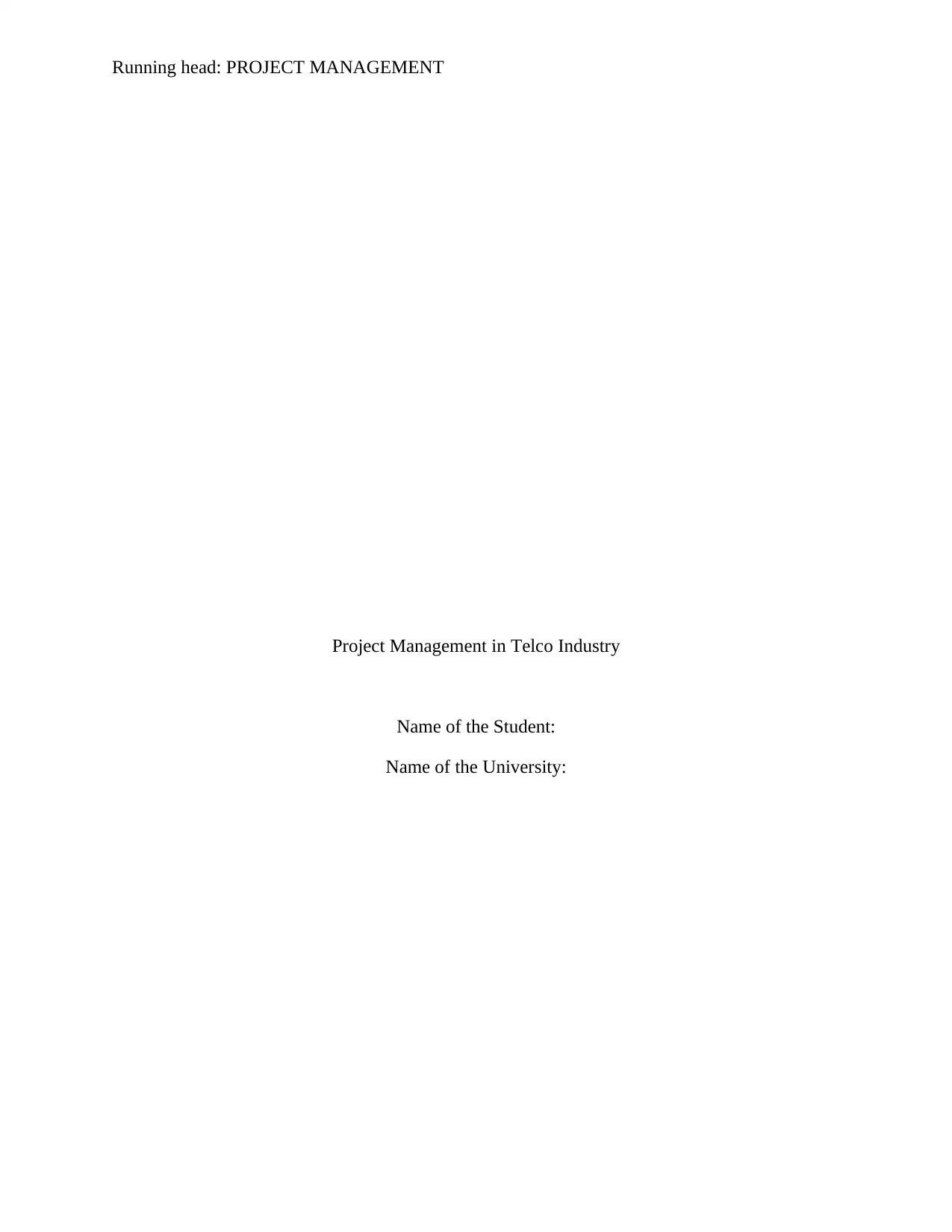
Running head: PROJECT MANAGEMENT
Project Management in Telco Industry
Name of the Student:
Name of the University:
Project Management in Telco Industry
Name of the Student:
Name of the University:
Paraphrase This Document
Need a fresh take? Get an instant paraphrase of this document with our AI Paraphraser
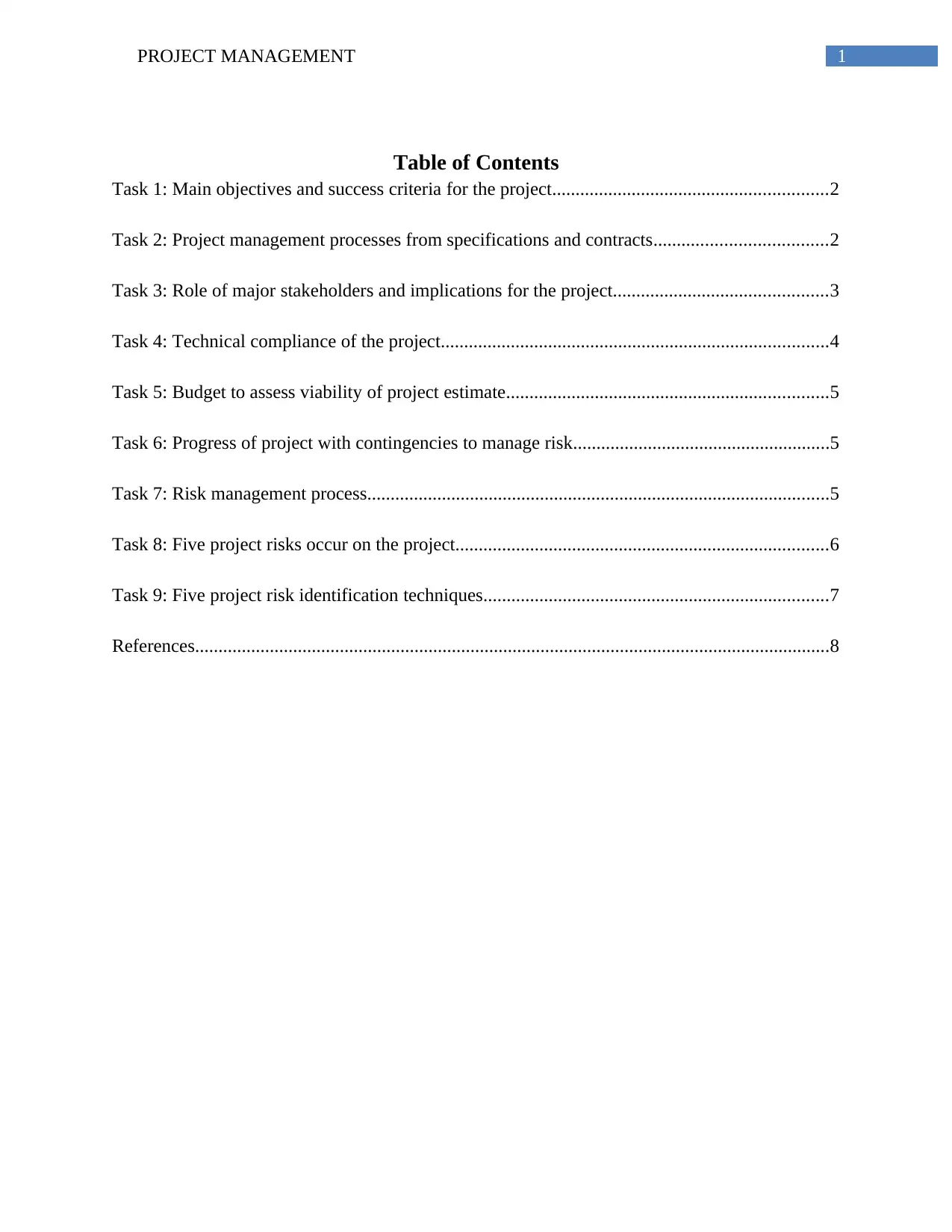
1PROJECT MANAGEMENT
Table of Contents
Task 1: Main objectives and success criteria for the project...........................................................2
Task 2: Project management processes from specifications and contracts.....................................2
Task 3: Role of major stakeholders and implications for the project..............................................3
Task 4: Technical compliance of the project...................................................................................4
Task 5: Budget to assess viability of project estimate.....................................................................5
Task 6: Progress of project with contingencies to manage risk.......................................................5
Task 7: Risk management process...................................................................................................5
Task 8: Five project risks occur on the project................................................................................6
Task 9: Five project risk identification techniques..........................................................................7
References........................................................................................................................................8
Table of Contents
Task 1: Main objectives and success criteria for the project...........................................................2
Task 2: Project management processes from specifications and contracts.....................................2
Task 3: Role of major stakeholders and implications for the project..............................................3
Task 4: Technical compliance of the project...................................................................................4
Task 5: Budget to assess viability of project estimate.....................................................................5
Task 6: Progress of project with contingencies to manage risk.......................................................5
Task 7: Risk management process...................................................................................................5
Task 8: Five project risks occur on the project................................................................................6
Task 9: Five project risk identification techniques..........................................................................7
References........................................................................................................................................8
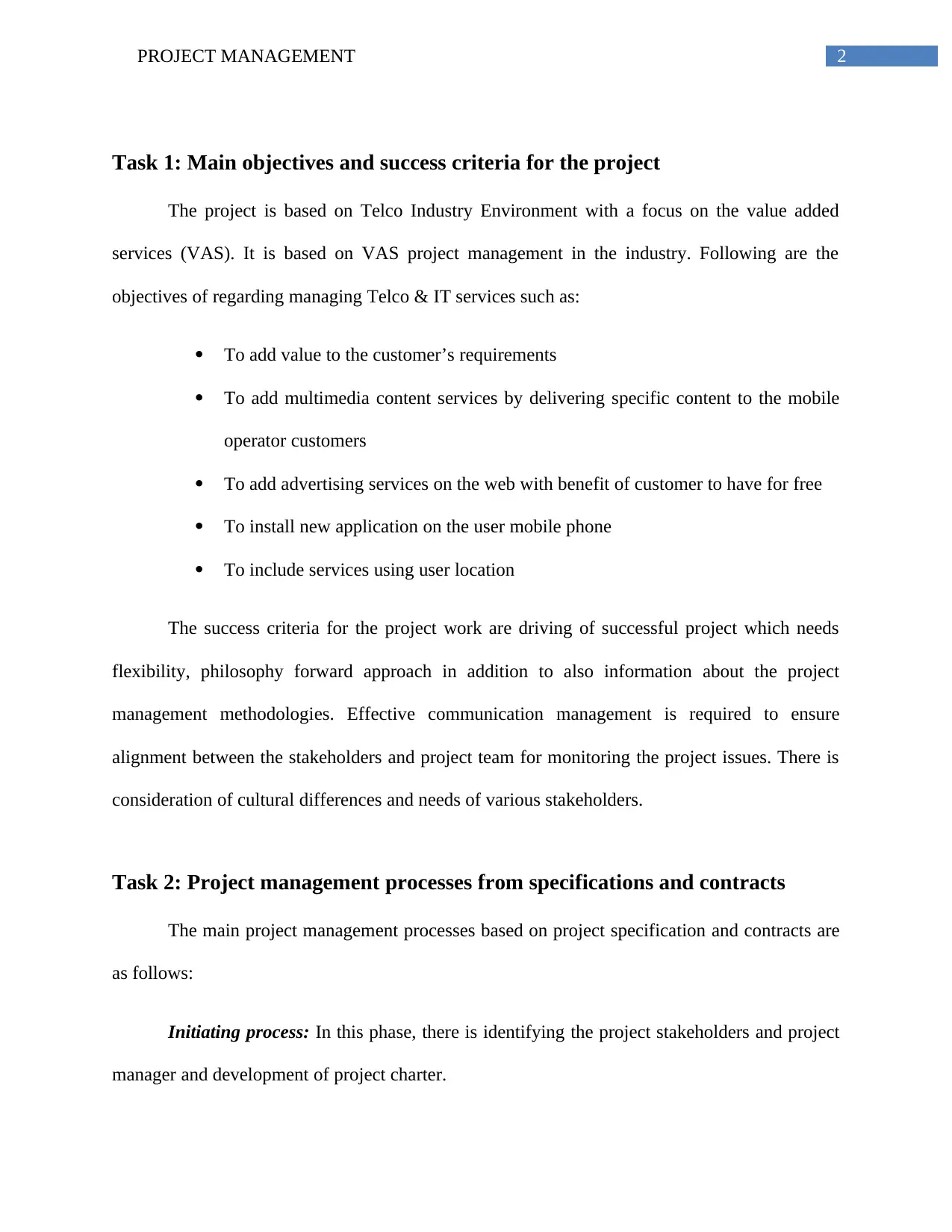
2PROJECT MANAGEMENT
Task 1: Main objectives and success criteria for the project
The project is based on Telco Industry Environment with a focus on the value added
services (VAS). It is based on VAS project management in the industry. Following are the
objectives of regarding managing Telco & IT services such as:
To add value to the customer’s requirements
To add multimedia content services by delivering specific content to the mobile
operator customers
To add advertising services on the web with benefit of customer to have for free
To install new application on the user mobile phone
To include services using user location
The success criteria for the project work are driving of successful project which needs
flexibility, philosophy forward approach in addition to also information about the project
management methodologies. Effective communication management is required to ensure
alignment between the stakeholders and project team for monitoring the project issues. There is
consideration of cultural differences and needs of various stakeholders.
Task 2: Project management processes from specifications and contracts
The main project management processes based on project specification and contracts are
as follows:
Initiating process: In this phase, there is identifying the project stakeholders and project
manager and development of project charter.
Task 1: Main objectives and success criteria for the project
The project is based on Telco Industry Environment with a focus on the value added
services (VAS). It is based on VAS project management in the industry. Following are the
objectives of regarding managing Telco & IT services such as:
To add value to the customer’s requirements
To add multimedia content services by delivering specific content to the mobile
operator customers
To add advertising services on the web with benefit of customer to have for free
To install new application on the user mobile phone
To include services using user location
The success criteria for the project work are driving of successful project which needs
flexibility, philosophy forward approach in addition to also information about the project
management methodologies. Effective communication management is required to ensure
alignment between the stakeholders and project team for monitoring the project issues. There is
consideration of cultural differences and needs of various stakeholders.
Task 2: Project management processes from specifications and contracts
The main project management processes based on project specification and contracts are
as follows:
Initiating process: In this phase, there is identifying the project stakeholders and project
manager and development of project charter.
⊘ This is a preview!⊘
Do you want full access?
Subscribe today to unlock all pages.

Trusted by 1+ million students worldwide
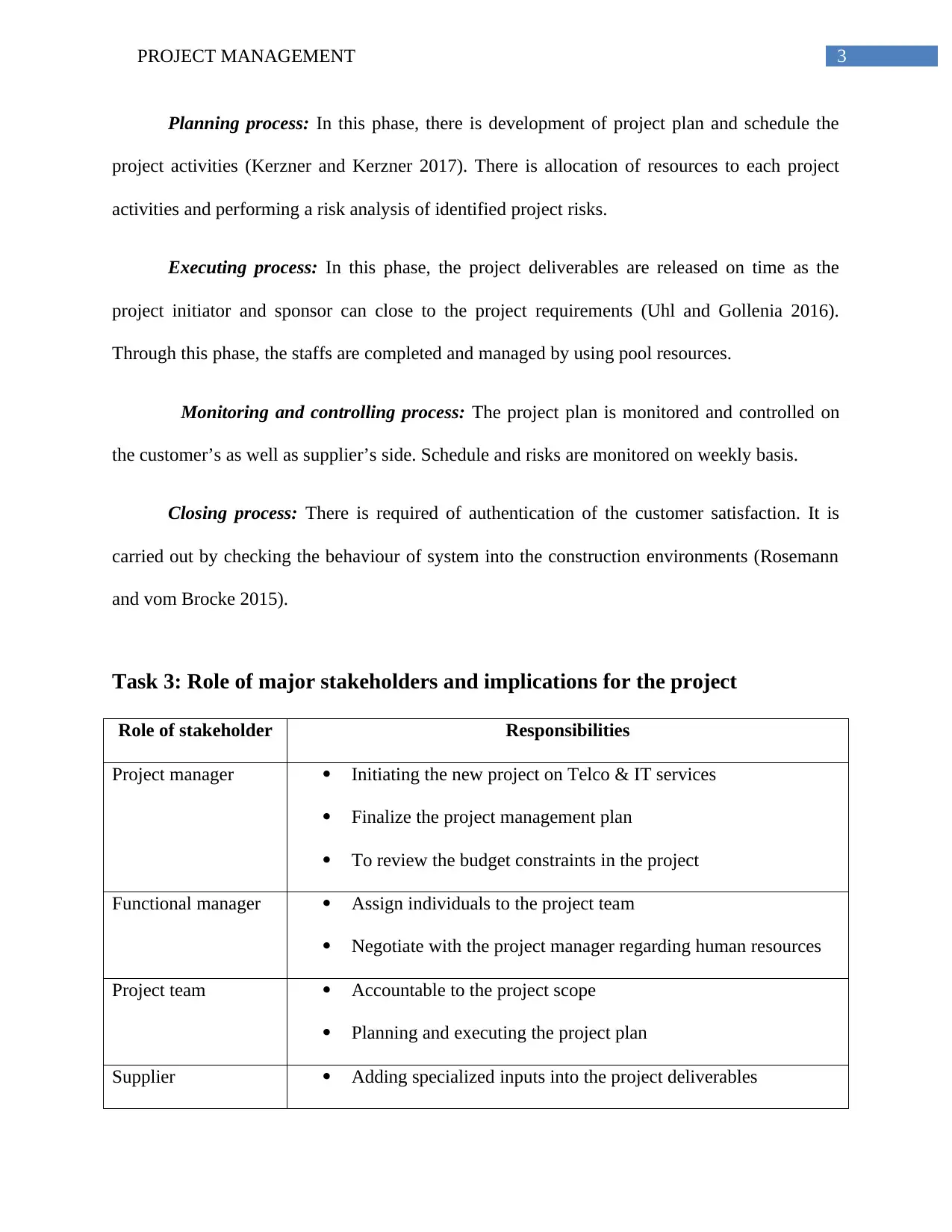
3PROJECT MANAGEMENT
Planning process: In this phase, there is development of project plan and schedule the
project activities (Kerzner and Kerzner 2017). There is allocation of resources to each project
activities and performing a risk analysis of identified project risks.
Executing process: In this phase, the project deliverables are released on time as the
project initiator and sponsor can close to the project requirements (Uhl and Gollenia 2016).
Through this phase, the staffs are completed and managed by using pool resources.
Monitoring and controlling process: The project plan is monitored and controlled on
the customer’s as well as supplier’s side. Schedule and risks are monitored on weekly basis.
Closing process: There is required of authentication of the customer satisfaction. It is
carried out by checking the behaviour of system into the construction environments (Rosemann
and vom Brocke 2015).
Task 3: Role of major stakeholders and implications for the project
Role of stakeholder Responsibilities
Project manager Initiating the new project on Telco & IT services
Finalize the project management plan
To review the budget constraints in the project
Functional manager Assign individuals to the project team
Negotiate with the project manager regarding human resources
Project team Accountable to the project scope
Planning and executing the project plan
Supplier Adding specialized inputs into the project deliverables
Planning process: In this phase, there is development of project plan and schedule the
project activities (Kerzner and Kerzner 2017). There is allocation of resources to each project
activities and performing a risk analysis of identified project risks.
Executing process: In this phase, the project deliverables are released on time as the
project initiator and sponsor can close to the project requirements (Uhl and Gollenia 2016).
Through this phase, the staffs are completed and managed by using pool resources.
Monitoring and controlling process: The project plan is monitored and controlled on
the customer’s as well as supplier’s side. Schedule and risks are monitored on weekly basis.
Closing process: There is required of authentication of the customer satisfaction. It is
carried out by checking the behaviour of system into the construction environments (Rosemann
and vom Brocke 2015).
Task 3: Role of major stakeholders and implications for the project
Role of stakeholder Responsibilities
Project manager Initiating the new project on Telco & IT services
Finalize the project management plan
To review the budget constraints in the project
Functional manager Assign individuals to the project team
Negotiate with the project manager regarding human resources
Project team Accountable to the project scope
Planning and executing the project plan
Supplier Adding specialized inputs into the project deliverables
Paraphrase This Document
Need a fresh take? Get an instant paraphrase of this document with our AI Paraphraser
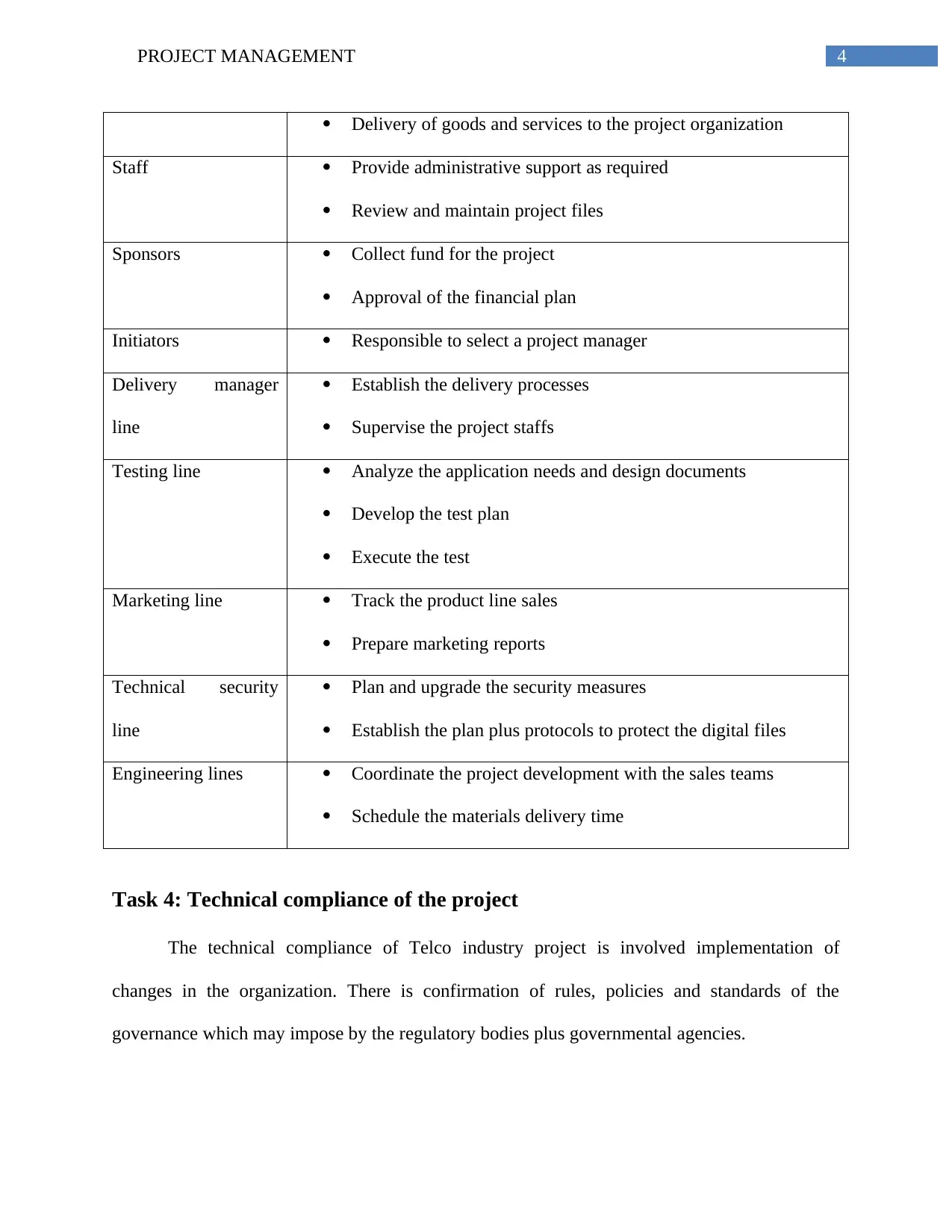
4PROJECT MANAGEMENT
Delivery of goods and services to the project organization
Staff Provide administrative support as required
Review and maintain project files
Sponsors Collect fund for the project
Approval of the financial plan
Initiators Responsible to select a project manager
Delivery manager
line
Establish the delivery processes
Supervise the project staffs
Testing line Analyze the application needs and design documents
Develop the test plan
Execute the test
Marketing line Track the product line sales
Prepare marketing reports
Technical security
line
Plan and upgrade the security measures
Establish the plan plus protocols to protect the digital files
Engineering lines Coordinate the project development with the sales teams
Schedule the materials delivery time
Task 4: Technical compliance of the project
The technical compliance of Telco industry project is involved implementation of
changes in the organization. There is confirmation of rules, policies and standards of the
governance which may impose by the regulatory bodies plus governmental agencies.
Delivery of goods and services to the project organization
Staff Provide administrative support as required
Review and maintain project files
Sponsors Collect fund for the project
Approval of the financial plan
Initiators Responsible to select a project manager
Delivery manager
line
Establish the delivery processes
Supervise the project staffs
Testing line Analyze the application needs and design documents
Develop the test plan
Execute the test
Marketing line Track the product line sales
Prepare marketing reports
Technical security
line
Plan and upgrade the security measures
Establish the plan plus protocols to protect the digital files
Engineering lines Coordinate the project development with the sales teams
Schedule the materials delivery time
Task 4: Technical compliance of the project
The technical compliance of Telco industry project is involved implementation of
changes in the organization. There is confirmation of rules, policies and standards of the
governance which may impose by the regulatory bodies plus governmental agencies.
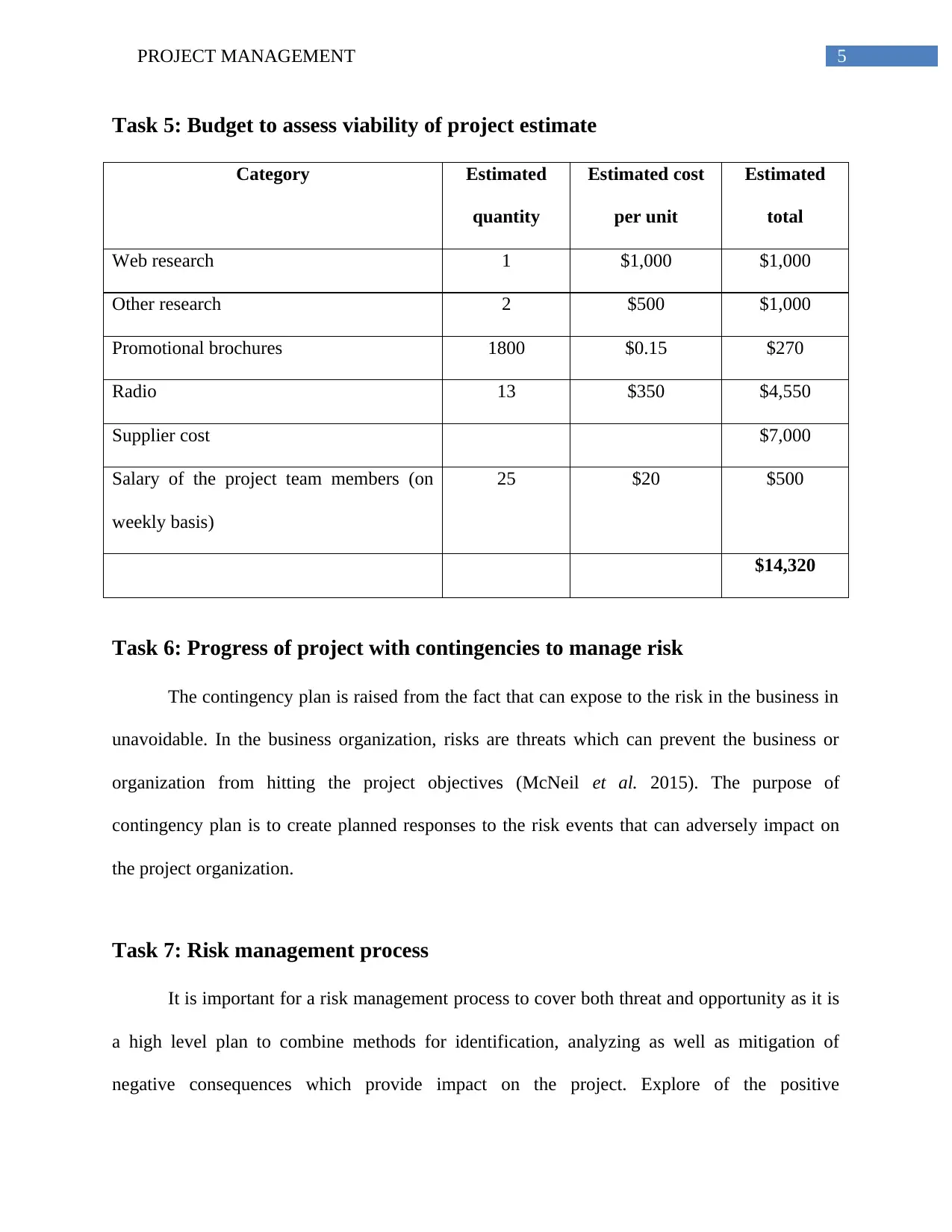
5PROJECT MANAGEMENT
Task 5: Budget to assess viability of project estimate
Category Estimated
quantity
Estimated cost
per unit
Estimated
total
Web research 1 $1,000 $1,000
Other research 2 $500 $1,000
Promotional brochures 1800 $0.15 $270
Radio 13 $350 $4,550
Supplier cost $7,000
Salary of the project team members (on
weekly basis)
25 $20 $500
$14,320
Task 6: Progress of project with contingencies to manage risk
The contingency plan is raised from the fact that can expose to the risk in the business in
unavoidable. In the business organization, risks are threats which can prevent the business or
organization from hitting the project objectives (McNeil et al. 2015). The purpose of
contingency plan is to create planned responses to the risk events that can adversely impact on
the project organization.
Task 7: Risk management process
It is important for a risk management process to cover both threat and opportunity as it is
a high level plan to combine methods for identification, analyzing as well as mitigation of
negative consequences which provide impact on the project. Explore of the positive
Task 5: Budget to assess viability of project estimate
Category Estimated
quantity
Estimated cost
per unit
Estimated
total
Web research 1 $1,000 $1,000
Other research 2 $500 $1,000
Promotional brochures 1800 $0.15 $270
Radio 13 $350 $4,550
Supplier cost $7,000
Salary of the project team members (on
weekly basis)
25 $20 $500
$14,320
Task 6: Progress of project with contingencies to manage risk
The contingency plan is raised from the fact that can expose to the risk in the business in
unavoidable. In the business organization, risks are threats which can prevent the business or
organization from hitting the project objectives (McNeil et al. 2015). The purpose of
contingency plan is to create planned responses to the risk events that can adversely impact on
the project organization.
Task 7: Risk management process
It is important for a risk management process to cover both threat and opportunity as it is
a high level plan to combine methods for identification, analyzing as well as mitigation of
negative consequences which provide impact on the project. Explore of the positive
⊘ This is a preview!⊘
Do you want full access?
Subscribe today to unlock all pages.

Trusted by 1+ million students worldwide
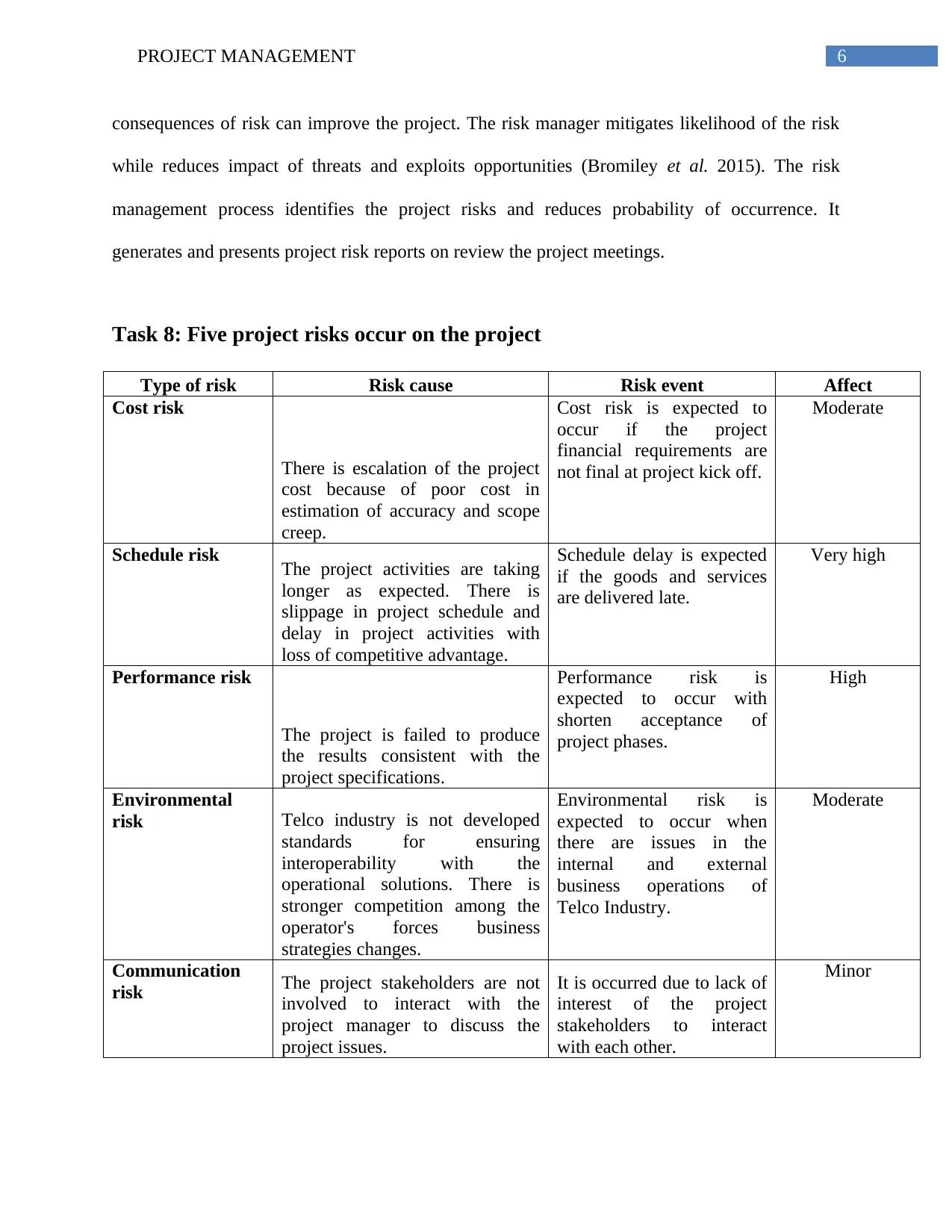
6PROJECT MANAGEMENT
consequences of risk can improve the project. The risk manager mitigates likelihood of the risk
while reduces impact of threats and exploits opportunities (Bromiley et al. 2015). The risk
management process identifies the project risks and reduces probability of occurrence. It
generates and presents project risk reports on review the project meetings.
Task 8: Five project risks occur on the project
Type of risk Risk cause Risk event Affect
Cost risk
There is escalation of the project
cost because of poor cost in
estimation of accuracy and scope
creep.
Cost risk is expected to
occur if the project
financial requirements are
not final at project kick off.
Moderate
Schedule risk The project activities are taking
longer as expected. There is
slippage in project schedule and
delay in project activities with
loss of competitive advantage.
Schedule delay is expected
if the goods and services
are delivered late.
Very high
Performance risk
The project is failed to produce
the results consistent with the
project specifications.
Performance risk is
expected to occur with
shorten acceptance of
project phases.
High
Environmental
risk Telco industry is not developed
standards for ensuring
interoperability with the
operational solutions. There is
stronger competition among the
operator's forces business
strategies changes.
Environmental risk is
expected to occur when
there are issues in the
internal and external
business operations of
Telco Industry.
Moderate
Communication
risk The project stakeholders are not
involved to interact with the
project manager to discuss the
project issues.
It is occurred due to lack of
interest of the project
stakeholders to interact
with each other.
Minor
consequences of risk can improve the project. The risk manager mitigates likelihood of the risk
while reduces impact of threats and exploits opportunities (Bromiley et al. 2015). The risk
management process identifies the project risks and reduces probability of occurrence. It
generates and presents project risk reports on review the project meetings.
Task 8: Five project risks occur on the project
Type of risk Risk cause Risk event Affect
Cost risk
There is escalation of the project
cost because of poor cost in
estimation of accuracy and scope
creep.
Cost risk is expected to
occur if the project
financial requirements are
not final at project kick off.
Moderate
Schedule risk The project activities are taking
longer as expected. There is
slippage in project schedule and
delay in project activities with
loss of competitive advantage.
Schedule delay is expected
if the goods and services
are delivered late.
Very high
Performance risk
The project is failed to produce
the results consistent with the
project specifications.
Performance risk is
expected to occur with
shorten acceptance of
project phases.
High
Environmental
risk Telco industry is not developed
standards for ensuring
interoperability with the
operational solutions. There is
stronger competition among the
operator's forces business
strategies changes.
Environmental risk is
expected to occur when
there are issues in the
internal and external
business operations of
Telco Industry.
Moderate
Communication
risk The project stakeholders are not
involved to interact with the
project manager to discuss the
project issues.
It is occurred due to lack of
interest of the project
stakeholders to interact
with each other.
Minor
Paraphrase This Document
Need a fresh take? Get an instant paraphrase of this document with our AI Paraphraser
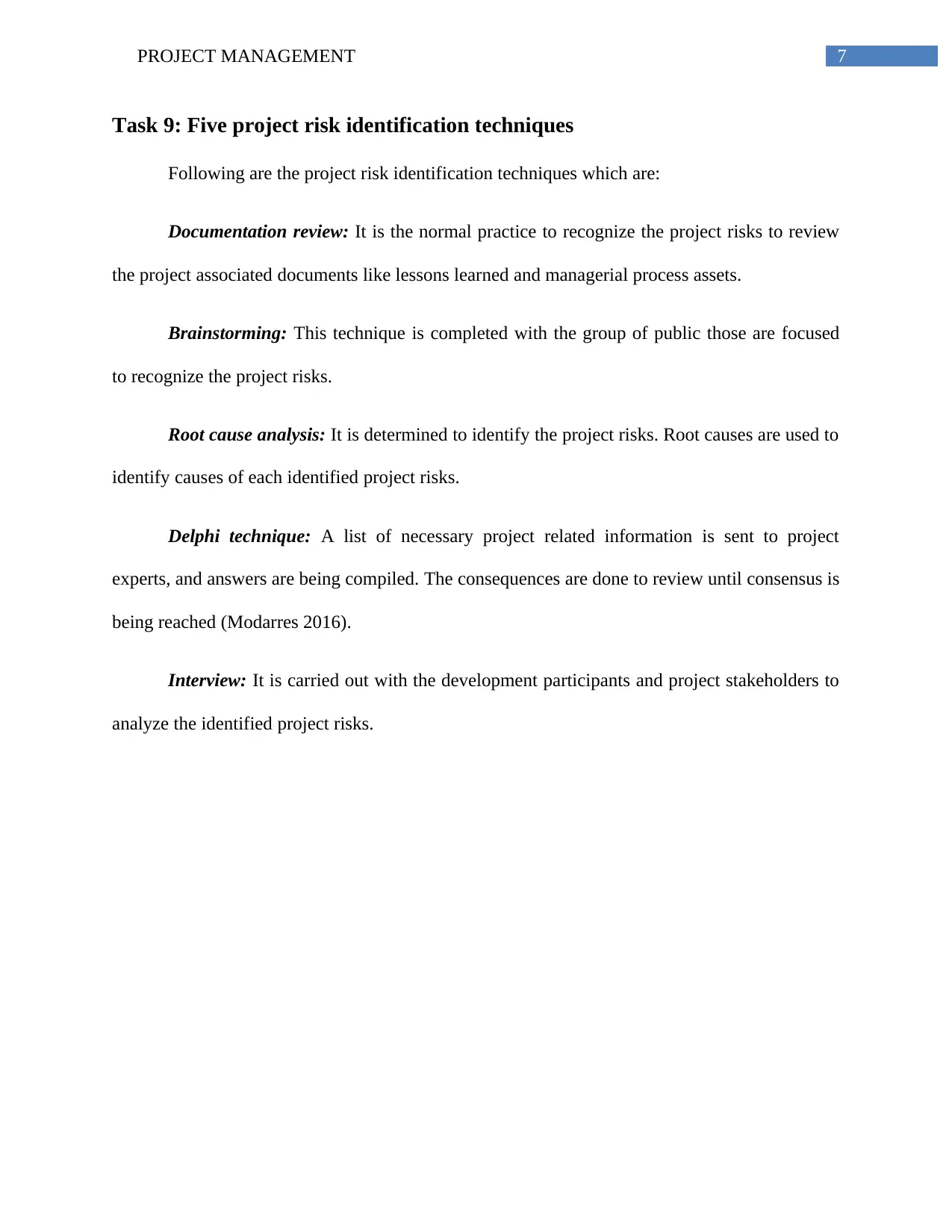
7PROJECT MANAGEMENT
Task 9: Five project risk identification techniques
Following are the project risk identification techniques which are:
Documentation review: It is the normal practice to recognize the project risks to review
the project associated documents like lessons learned and managerial process assets.
Brainstorming: This technique is completed with the group of public those are focused
to recognize the project risks.
Root cause analysis: It is determined to identify the project risks. Root causes are used to
identify causes of each identified project risks.
Delphi technique: A list of necessary project related information is sent to project
experts, and answers are being compiled. The consequences are done to review until consensus is
being reached (Modarres 2016).
Interview: It is carried out with the development participants and project stakeholders to
analyze the identified project risks.
Task 9: Five project risk identification techniques
Following are the project risk identification techniques which are:
Documentation review: It is the normal practice to recognize the project risks to review
the project associated documents like lessons learned and managerial process assets.
Brainstorming: This technique is completed with the group of public those are focused
to recognize the project risks.
Root cause analysis: It is determined to identify the project risks. Root causes are used to
identify causes of each identified project risks.
Delphi technique: A list of necessary project related information is sent to project
experts, and answers are being compiled. The consequences are done to review until consensus is
being reached (Modarres 2016).
Interview: It is carried out with the development participants and project stakeholders to
analyze the identified project risks.
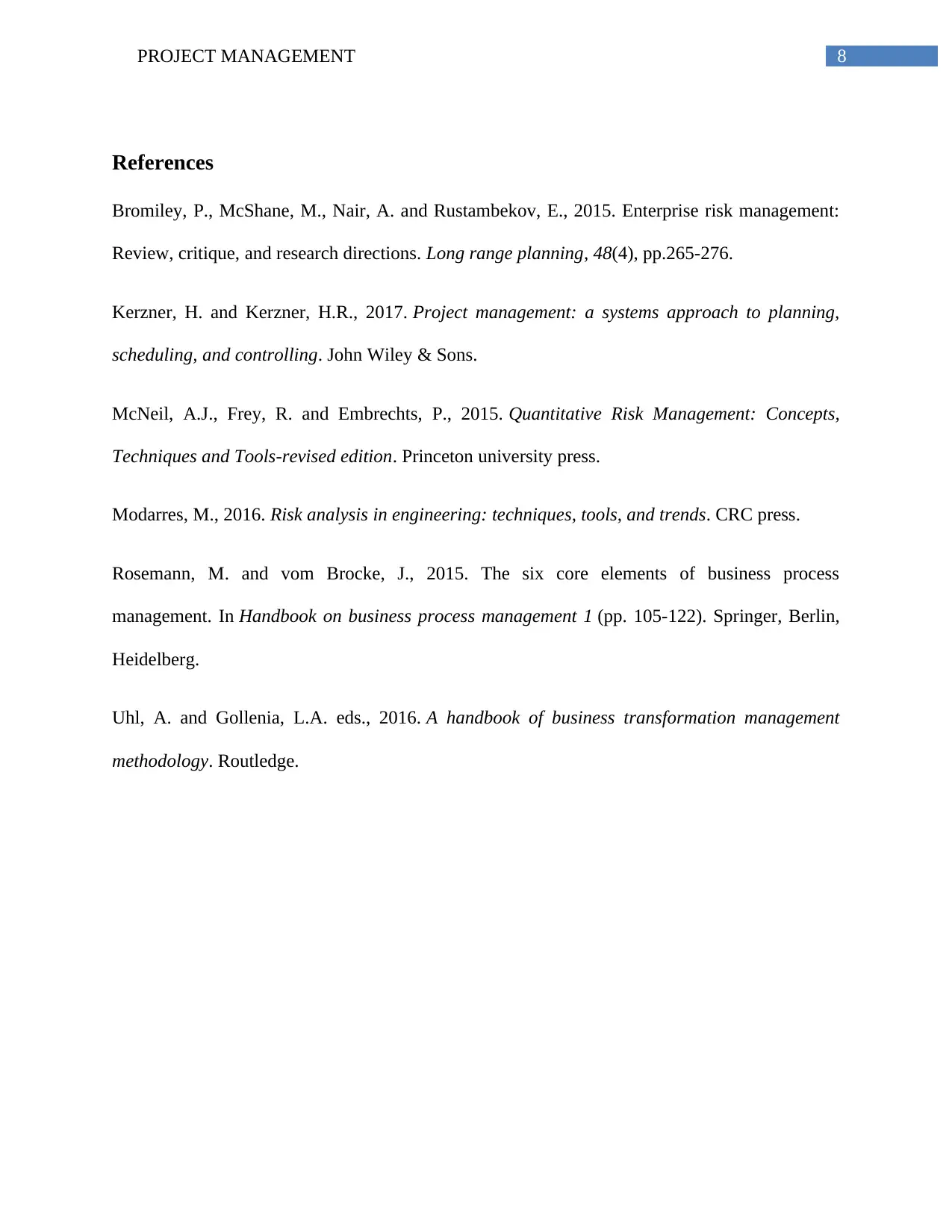
8PROJECT MANAGEMENT
References
Bromiley, P., McShane, M., Nair, A. and Rustambekov, E., 2015. Enterprise risk management:
Review, critique, and research directions. Long range planning, 48(4), pp.265-276.
Kerzner, H. and Kerzner, H.R., 2017. Project management: a systems approach to planning,
scheduling, and controlling. John Wiley & Sons.
McNeil, A.J., Frey, R. and Embrechts, P., 2015. Quantitative Risk Management: Concepts,
Techniques and Tools-revised edition. Princeton university press.
Modarres, M., 2016. Risk analysis in engineering: techniques, tools, and trends. CRC press.
Rosemann, M. and vom Brocke, J., 2015. The six core elements of business process
management. In Handbook on business process management 1 (pp. 105-122). Springer, Berlin,
Heidelberg.
Uhl, A. and Gollenia, L.A. eds., 2016. A handbook of business transformation management
methodology. Routledge.
References
Bromiley, P., McShane, M., Nair, A. and Rustambekov, E., 2015. Enterprise risk management:
Review, critique, and research directions. Long range planning, 48(4), pp.265-276.
Kerzner, H. and Kerzner, H.R., 2017. Project management: a systems approach to planning,
scheduling, and controlling. John Wiley & Sons.
McNeil, A.J., Frey, R. and Embrechts, P., 2015. Quantitative Risk Management: Concepts,
Techniques and Tools-revised edition. Princeton university press.
Modarres, M., 2016. Risk analysis in engineering: techniques, tools, and trends. CRC press.
Rosemann, M. and vom Brocke, J., 2015. The six core elements of business process
management. In Handbook on business process management 1 (pp. 105-122). Springer, Berlin,
Heidelberg.
Uhl, A. and Gollenia, L.A. eds., 2016. A handbook of business transformation management
methodology. Routledge.
⊘ This is a preview!⊘
Do you want full access?
Subscribe today to unlock all pages.

Trusted by 1+ million students worldwide
1 out of 9
Related Documents
Your All-in-One AI-Powered Toolkit for Academic Success.
+13062052269
info@desklib.com
Available 24*7 on WhatsApp / Email
![[object Object]](/_next/static/media/star-bottom.7253800d.svg)
Unlock your academic potential
Copyright © 2020–2025 A2Z Services. All Rights Reserved. Developed and managed by ZUCOL.



